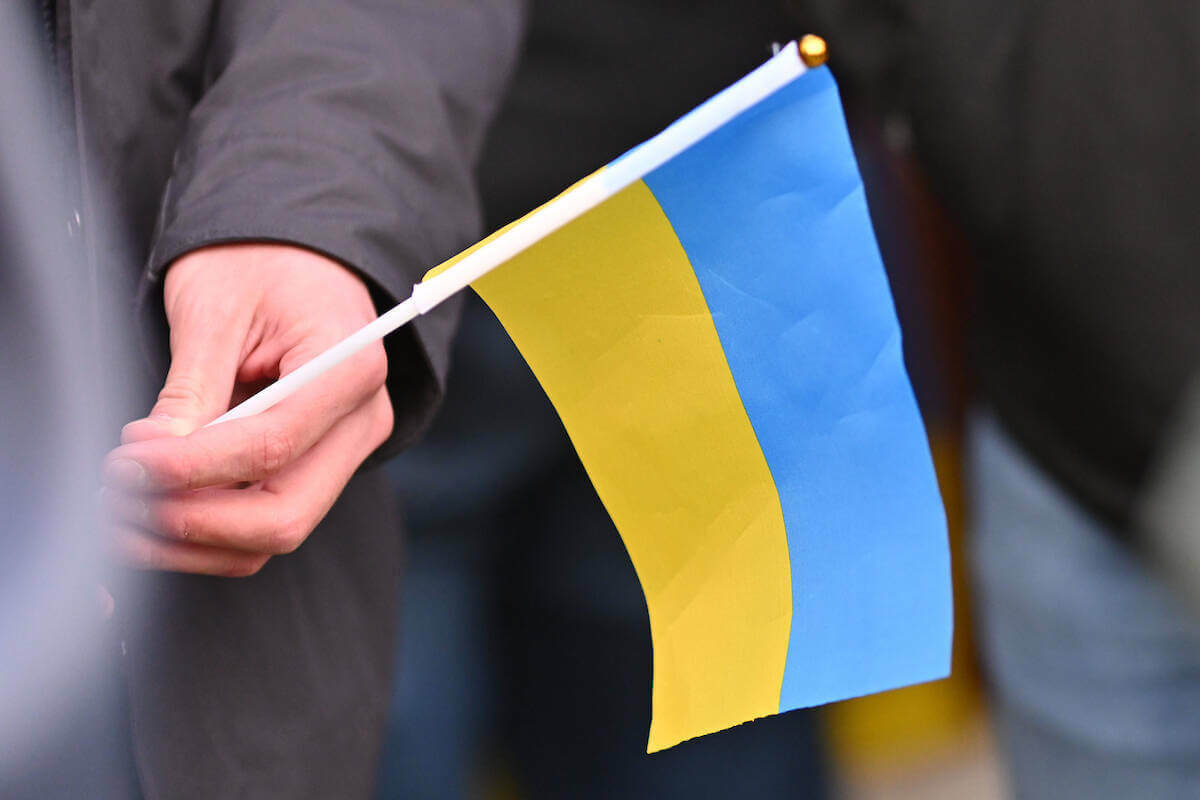The traditional products, local breeds, and know-how collected by the Ark of Taste belong to the communities that have preserved them over time. They have been shared and described here thanks to the efforts of the network that that Slow Food has developed around the world, with the objective of preserving them and raising awareness.
Hutsul Syr

Hutsul syr is one of the cheeses made by the Hutsul people of the Ukrainian Carpathians. (Syrsimply means “cheese.â€) It is an acid coagulated cheese. An especially important ritual food for Easter, syr should be among the foods brought to church in the typical Easter basket.
Hutsul syr is prepared from fresh milk that is filtered and then put on the fire to boil. A local product called guslianka, made from sour milk, is used for fermentation. The curd is placed in a low, round form, and left to drain. The next day the cheese is ready. Syr is made with milk from the local brown Carpathian cow, a breed that derived from the original Hutsul cattle. During the summer the cows graze in meadows, and during the winter they are kept in a stall.
A reduction in the number of cattle raised on family farms has led to a decrease in the production and use of homemade syr, and many Hutsuls now use cottage cheese instead.
Hutsul syr can be consumed plain as an accompaniment to wine, and pairs well with fruits, vegetables, and honey. It can also be fried in butter or grilled.
Matsyk

Matsyk is a type of raw, cured meat, made of locally produced choice pork. The production process consists of several steps over three to twelve months. First, the sinew and fat is removed from a pork leg, and the meat is cut into small chunks. The pieces of meat are spiced with a mixture of salt, sugar, black pepper, coriander, mustard seeds and bay leaf. The spiced meat is kept in a cool room (about 5°C) for several days, occasionally mixed. Then, the marinated meat is stuffed into a casing made from the animal’s stomach. It may then be pressed to remove excess liquid or directly hung in a dry place. In some homes, matsyk is hung along the roof where hay is stored and takes on some of the hay aroma. Curing lasts three to twelve months, and during this matsyk loses up to 50% of its weight.
Matsyk has a long history in Eastern Europe and particularly northern Ukraine, specifically in Volodymyrets, Sarny, Dubrovytsia, and Zarichne Districts of the Rivne Region, and Manevytskyi and Liubeshivskyi District of the Volyn Region. It dates from the times when modern technologies of meat storage did not yet exist, but there was a need for long-term meat preservation. The pork would be cut before Christmas, mixed with salt and cured for minimum of three months. It was very popular among travelers, warriors and merchants.
Today, there is no matsyk production on an industrial level, and it cannot be found in the supermarkets, only bought directly from the manufacturer. The product is made at homes for personal use and for direct sale to individual customers. As matsyk is made of high-quality meat and is up to three or four times more expensive than other salami or meat products found in supermarkets, it is much less popular and even unknown to many people
Poltavsaya Glinistaya Chicken

The mots famous chicken in Ukraine and abroad are Poltavskaya chicken, and with them a typical Ukrainian yard is associated. It is unknown when the chicken breeding started (approximately in XIX century). There is an opinion that they have been bred in Poltava Guberniya thanks to folk selection, the selection was based on local chicken breeds. Within the period 1930-1941 most of collective farms started breeding chickens of the breed white leghorn and others, while local poultry was almost forgotten. Though Poltava region population preferred in their yards exclusively Poltavskaya chickens, which were better regarding meat quality and were more adapted to the conditions and food and their egg-laying ability is definitely not worse.
The main kind of Poltavskaya chicken is of clay-colour (brown-yellowish). The tips of flight feathers are black, the tail is brown-black. Roosters have a lighter neck than hens. Baby chicks are covered in light brown fur. The bird has a golden gene, that is responsible for such feather colour. Other kinds of Poltavskaya chicken based on their feathers colour. black or zozuliastaya (cuckoo from Ukrainian). Zoluliastaya kind of Poltavskaya chicken is considered to be lost during the last 10-15 years, a similar fate may expect the clay kind as well.
Clay chickens are a meat-egg kind, they are very resistant and adapt easily to any conditions. A rooster weighs about 3 kg, a chicken weighs about 2 kg. The egg-laying capacity of clay chickens are 160-215 eggs per year, the egg shell is brown.
The industrial chicken farming caused the decrease in number and productivity of the local chickens. They are bred in private farms and are kept in collection scientific centres as genetic reserves.
Telti-Kuruk Grape

Telti-Kuruk is a unique autochthonous grape variety first planted in the village of Shabo, Odessa Oblast, during the Turkish reign. Telti-Kuruk grows almost only in Shabo region. The climate of the Black Sea Lowland has a beneficial effect on the development of viticulture and winemaking. A bunch of Telti-Kuruk grapes is medium sized (16 cm in length, 9 cm in width), bunch’s mass is 90-134 grams. A berry is medium sized or small, weakly-oval, yellowish-green with a thick wax coating. Skin is thin and strong. Flesh is juicy and soft.
The grape is used to produce Shabo vintage white table wine, champagne wine materials and juices. Telti-Kuruk grape variety is suitable to eat fresh. The total area of the grape plantings of this unique variety is about 70 hectares.
Traditional Ukrainian Postila

Postila is a traditional fruit preserve from Ukraine. It may be yellowish, orange, or even purple, depending on the kind of fruit used. It is mostly made from sour apples; nowadays, both traditional and modern apple varieties are used, including Antonovka (a group of sour, late-ripening cultivars), Renet Simirenko, Florin, Radogost, Eder, Pinova, Gala, and Delicious. The fruit is cooked, pureed (often simply by pressing it through a sieve), and then spread out to dry in a dehydrator, in the oven, or outside in the sun; in the old days, the puree was dried on a piece of canvas in an alder wood frame. Ideally, the puree should be dried at a temperature of no more than 40 °C, in order to preserve its full flavor and nutritional value, and it should not be over dried, or it will become brittle. Once sufficiently dry, the chewy, humid fruit sheets may be cut into pieces or rolled tightly into tubes, which are typically 16 centimeters long, 1.5-2 cm wide, and 35-40 grams. Postila is traditionally sweetened with honey, which may be added to the puree or drizzled on the dried sheets. Nuts or a mixture of berries or other fruits may be sprinkled on the sheets before rolling them up, and cinnamon is sometimes added to extend shelf life. Before being served, the tubes are cut into short pieces, or “snails.†Postila is usually eaten as a snack but can also be served as a dessert. It accompanies tea or hot milk with honey, or may be mixed with sour cream and sprinkled with cranberries. It can also be used to flavor ice cream, soups, or savory gravies.
Postila dates back at least to the early 14th century. It may have been introduced to Ukraine by nomadic peoples such as the Tatars, and it is sill considered a good travel snack. It was developed as a method for preserving fruit for the winter, when it was a crucial source of vitamins and other nutrients that would otherwise not have been available. Postila was most often made with apples of various varieties collected from local gardens or small orchards, and was prepared by women and girls, with knowledge thus passing from one generation to the next. Products similar to postila exist throughout Eastern Europe, as well as in the Caucasus and Central Asia. In particular, Ukraine shares many aspects of its food culture and gastronomic heritage with Belarus, Russia, Lithuania, and Poland. Postila belongs to the same family of products as zephyr and “apple cheese,†both of which are also well known in these countries. Old Polish cookbooks contain recipes for pastyle ruskie, Rus being the old name of the region that includes what is now Ukraine. These old recipes call for honey, not sugar, and the use of honey remains a defining feature of traditional Ukrainian postila. By the end of the 19th century, postila had become famous throughout Europe: Ukraine’s abundant orchards provided fruits and fruit products to the Russian Empire, and many of these were then exported to the rest of Europe, such that postila made it to the tables of prosperous people in Italy, Spain, France, and elsewhere. Thanks to this history, postila, or pastila, is often misunderstood to be an exclusively Russian product, but Russian pastila differs from Ukrainian postila: The Russian version is thicker and is made with sugar, not honey.
Today, traditional Ukrainian postila is becoming difficult to find. It has been largely replaced by mass-produced pastila (паÑтила), which is made with sugar rather than honey, and from industrially grown apples that are treated with chemicals and are often not local varieties. The drying process is accelerated with the use of high temperatures, which compromise the authentic flavor and beneficial nutritional properties of the final product. In addition, mass-produced postila is sold in plastic packaging – traditionally, postila was always stored in tins or wooden boxes. Those who continue to produce traditional postila play an important role in safeguarding the biodiversity of local fruit varieties and supporting good, clean and fair small-scale farmers.
To be continued...





















